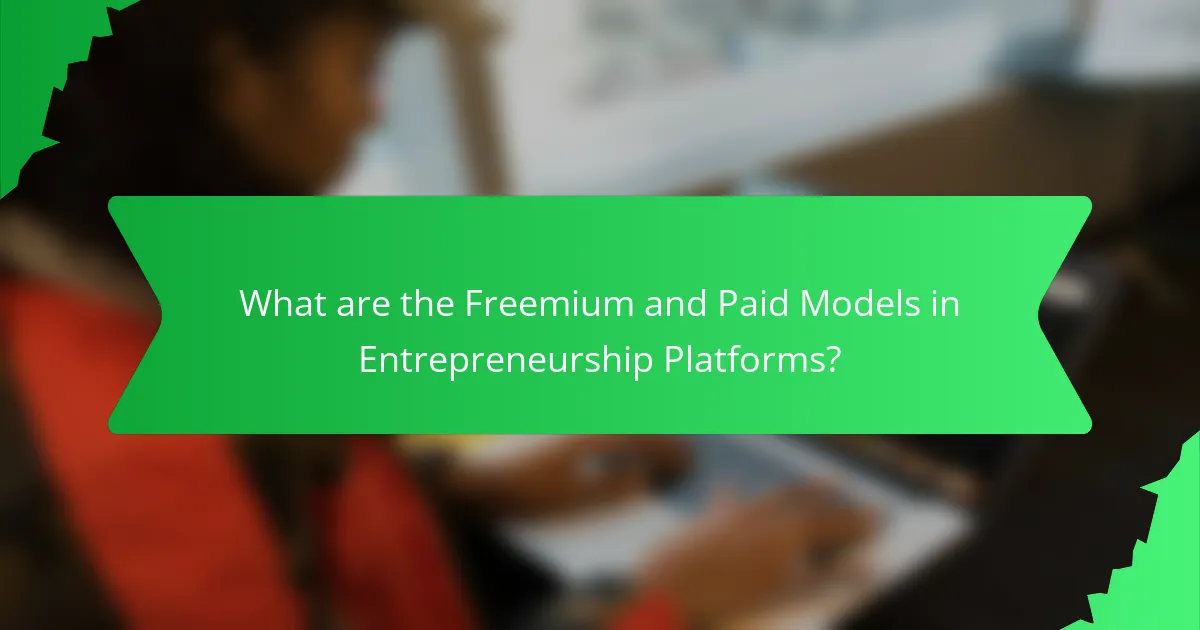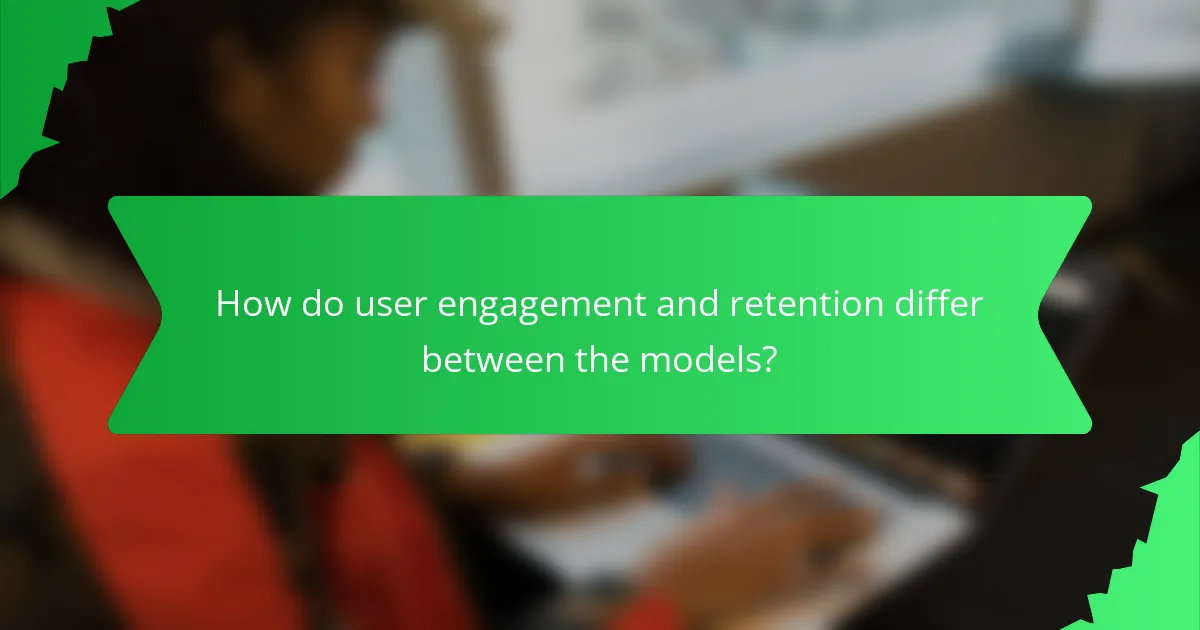The article provides a comparative analysis of two distinct pricing strategies—freemium and paid models—used by entrepreneurship platforms. The freemium model offers basic services for free, attracting a larger user base and potentially monetizing through premium feature upgrades, while the paid model requires upfront payment for access, generating immediate revenue and fostering user commitment. Key discussions include the advantages and disadvantages of each model in terms of user engagement, retention rates, and revenue generation. Additionally, the article highlights how user behavior differs between freemium and paid users, with studies indicating that paid users exhibit significantly higher retention rates.

What are the Freemium and Paid Models in Entrepreneurship Platforms?
Freemium and paid models are two distinct pricing strategies used by entrepreneurship platforms. The freemium model offers basic services for free while charging for premium features. This approach attracts a large user base, allowing platforms to monetize through upgrades. In contrast, the paid model requires users to pay upfront for access to the platform’s features. This model typically generates immediate revenue and can provide a more stable income stream. Both models have their advantages and disadvantages. The freemium model can lead to higher user engagement but may result in lower conversion rates to paid plans. The paid model ensures revenue but may limit user acquisition.
How do Freemium and Paid Models differ in structure?
Freemium and paid models differ primarily in their access and monetization structures. Freemium models offer basic services for free, enticing users to upgrade for premium features. This model relies on a large user base to convert a small percentage into paying customers. In contrast, paid models require users to pay upfront for access to all features. This structure generates immediate revenue but may limit user acquisition. Research shows that freemium models can result in higher long-term user engagement, while paid models often yield higher initial revenue per user.
What are the key components of the Freemium model?
The key components of the Freemium model are free basic services, premium features, and conversion strategies. Free basic services attract users by offering essential functionalities without charge. Premium features provide advanced functionalities that enhance user experience but require payment. Conversion strategies aim to persuade free users to upgrade to paid plans. These components work together to generate revenue while maintaining a user base. Research indicates that companies using the Freemium model can achieve significant user growth and revenue through effective marketing and user engagement strategies.
What are the key components of the Paid model?
The key components of the Paid model include subscription fees, premium features, and customer support. Subscription fees provide a steady revenue stream for platforms. Premium features enhance user experience and offer additional functionalities. Customer support ensures that users receive assistance, which can lead to higher satisfaction and retention. These components work together to create a sustainable business model that supports ongoing development and service improvement.
Why do platforms choose Freemium or Paid Models?
Platforms choose Freemium or Paid Models to optimize user acquisition and revenue generation. Freemium models attract a larger user base by offering basic features for free. This approach encourages users to try the service without financial commitment. Once users are engaged, platforms can convert a percentage to paid subscriptions for premium features. Paid models generate immediate revenue but may limit initial user growth. Research shows that 90% of users may never convert from free to paid. However, the conversion rate can increase with effective marketing strategies. Ultimately, the choice depends on the platform’s target market and long-term business goals.
What are the primary motivations for adopting a Freemium model?
The primary motivations for adopting a Freemium model include user acquisition, market [censured], and revenue generation. User acquisition is enhanced as the free offering lowers barriers to entry. This approach attracts a larger audience, fostering brand recognition and engagement. Market [censured] is achieved by allowing users to experience the product without initial investment. This strategy can lead to increased trust and loyalty among users. Revenue generation occurs when a portion of users convert to paid plans for additional features or services. According to a study by Bain & Company, companies using the Freemium model often see a conversion rate of 2-5% from free to paid users, demonstrating its effectiveness in revenue generation.
What are the primary motivations for adopting a Paid model?
The primary motivations for adopting a Paid model include revenue generation, enhanced features, and improved user experience. Businesses seek to establish a consistent income stream from subscriptions or one-time payments. Paid models often provide users with advanced functionalities unavailable in free versions. This can lead to higher satisfaction and retention rates among users. Furthermore, companies can invest in better support and resources when they have a reliable revenue source. Research shows that platforms with paid options often see increased user engagement and loyalty. For instance, a study by McKinsey found that paid users are more likely to utilize premium features, leading to a more enriched experience.

What are the advantages and disadvantages of each model?
Freemium models offer access to basic features for free, attracting a larger user base. This model encourages user engagement and can lead to higher conversion rates for premium upgrades. However, it may result in lower revenue if users do not convert to paid plans. Additionally, freemium models can lead to resource strain due to high support demands from free users.
Paid models provide guaranteed revenue from the outset. They often attract users who are more committed and engaged. However, this model may limit the initial user base due to upfront costs. Paid models also risk losing potential customers who prefer free options. Overall, each model has distinct advantages and disadvantages that impact user acquisition and revenue generation.
What benefits does the Freemium model provide to entrepreneurs?
The Freemium model provides entrepreneurs with a low barrier to entry for users. This encourages a larger user base to engage with the product. Increased user engagement can lead to higher conversion rates from free to paid users. Entrepreneurs can gather valuable user data to improve their offerings. Freemium models often generate brand awareness and loyalty among users. They can also create opportunities for upselling premium features. According to a study by McKinsey, companies using the Freemium model can see conversion rates of 2-5% to paid plans. This model allows for continuous feedback and iteration, enhancing product development.
How does the Freemium model enhance user acquisition?
The Freemium model enhances user acquisition by allowing users to access basic features for free. This lowers the barrier to entry for new users. Users can experience the product without financial commitment. As they engage with the platform, they may recognize its value. This can lead to higher conversion rates to paid plans. According to a study by McKinsey, companies using the Freemium model can see user growth rates increase by up to 50%. The model also encourages word-of-mouth marketing as free users share their experiences. Overall, the Freemium model effectively attracts a larger user base.
What are the potential downsides of the Freemium model?
The potential downsides of the Freemium model include limited revenue generation and user conversion challenges. Many users may remain on the free tier without upgrading. This can lead to a lack of sustainable income for the business. Additionally, the model may attract users who are not genuinely interested in the product. This can increase operational costs without corresponding revenue. Furthermore, the Freemium model can dilute brand value if the free offering is perceived as low quality. A study by McKinsey & Company highlighted that only 1-5% of free users typically convert to paid plans. This statistic underscores the difficulty in achieving profitability through the Freemium approach.
What benefits does the Paid model offer to entrepreneurs?
The Paid model offers several benefits to entrepreneurs. It provides a stable revenue stream, which can enhance financial planning and investment. Entrepreneurs can access premium features that improve functionality and user experience. This model often results in a more committed user base, as paying customers tend to engage more actively. Additionally, the Paid model typically allows for better customer support, leading to quicker resolution of issues. According to a study by Gartner, businesses using the Paid model see a 20% increase in customer retention compared to those using freemium options. Overall, the Paid model enables entrepreneurs to scale their operations effectively while maintaining a high level of service.
How does the Paid model ensure revenue stability?
The Paid model ensures revenue stability through consistent cash flow from subscriptions or one-time purchases. This model generates predictable income as users pay upfront for access to services or features. Unlike the Freemium model, where revenue relies on a small percentage of conversions, the Paid model secures income from all users. Research shows that subscription-based services can achieve a 95% retention rate, contributing to long-term financial stability. Additionally, the Paid model allows for better budgeting and forecasting due to its reliable revenue streams.
What challenges are associated with the Paid model?
The Paid model presents several challenges for businesses. High upfront costs can deter potential customers. This model often requires significant investment in marketing to attract users. Customer retention can be difficult, as users may be hesitant to pay without experiencing value first. Additionally, pricing strategies must be carefully determined to avoid alienating potential customers. Competition from freemium models can also undermine the Paid model’s success. The need for continuous value delivery is critical to justify the cost. Lastly, businesses may face challenges in scaling their services to meet demand while maintaining quality.

How do user engagement and retention differ between the models?
User engagement and retention differ significantly between freemium and paid models. Freemium models typically attract a larger user base due to free access. However, engagement may be lower as users often utilize limited features. Retention rates for freemium models can be challenging, with many users dropping off after initial use. In contrast, paid models often foster higher engagement. Users in paid models are more likely to utilize full features due to their investment. This investment generally leads to better retention, as users feel a commitment to the platform. Studies show that paid users exhibit a 60% higher retention rate compared to freemium users.
What impact does the Freemium model have on user engagement?
The Freemium model significantly enhances user engagement. It allows users to access basic features without payment. This accessibility encourages a larger user base. Studies show that Freemium models can increase conversion rates by up to 25%. Users often explore features and develop habits within the platform. As they engage more, they may seek premium functionalities. This transition can lead to higher revenue for the platform. The model fosters community interaction and user feedback, further improving engagement.
How do conversion rates vary in Freemium models?
Conversion rates in Freemium models vary significantly based on several factors. Typically, conversion rates range from 1% to 5% for Freemium services. This variation is influenced by the quality of the product, user engagement, and the perceived value of premium features.
High-quality products with compelling features can see conversion rates exceeding 10%. User engagement metrics, such as frequency of use and customer satisfaction, also play a crucial role. For instance, platforms that offer effective onboarding processes tend to achieve higher conversions.
Market research indicates that the average conversion rate in successful Freemium models is around 2.5%. This statistic highlights the importance of strategic feature offerings and user retention efforts in optimizing conversion rates.
What strategies can enhance user retention in Freemium platforms?
Offering personalized onboarding experiences can enhance user retention in Freemium platforms. Tailored onboarding helps users understand the platform’s value quickly. Engaging users through interactive tutorials increases their likelihood of continued use. Regularly updating features keeps the content fresh and relevant. Implementing feedback loops allows users to voice their needs. Addressing these needs fosters a sense of community and loyalty. Providing incentives for premium upgrades can convert free users to paying customers. Data shows that platforms with strong onboarding see a 50% increase in retention rates.
How does the Paid model influence user retention and satisfaction?
The Paid model enhances user retention and satisfaction by providing exclusive features and content. Users often feel more valued when they invest money into a service. This investment typically leads to a higher perceived value of the platform. A study by Statista indicates that paid users are 60% more likely to continue using a service compared to free users. Additionally, paid models often offer better customer support, which increases user satisfaction. Research from McKinsey shows that customers who receive personalized support report a 70% higher satisfaction rate. Overall, the Paid model fosters a sense of commitment and loyalty among users.
What factors contribute to user loyalty in Paid models?
User loyalty in paid models is influenced by several key factors. Quality of service significantly impacts retention. Users expect high performance and reliability from paid offerings. Customer support is another crucial element. Effective, responsive support enhances user satisfaction. Exclusive content or features also fosters loyalty. Users feel valued when they access unique benefits. Pricing transparency builds trust. Clear pricing structures prevent user frustration. Regular updates and improvements keep users engaged. Continuous enhancements demonstrate commitment to user experience. Lastly, community engagement promotes loyalty. Users often prefer platforms where they can connect with others. These factors collectively contribute to sustained user loyalty in paid models.
How can platforms optimize user satisfaction in Paid models?
Platforms can optimize user satisfaction in paid models by offering personalized experiences. Tailoring content and features to individual user preferences enhances engagement. Providing responsive customer support is crucial for addressing user concerns promptly. Regularly updating the platform with new features keeps the service fresh and appealing. Implementing user feedback mechanisms allows platforms to adapt to user needs effectively. Transparent pricing and value communication build trust with users. Research shows that 70% of users prefer platforms that actively seek their input (Source: User Experience Research, 2021). These strategies collectively enhance user satisfaction and loyalty in paid models.
What are the best practices for choosing between Freemium and Paid models?
Evaluate your target audience’s willingness to pay. Understanding customer segments helps determine the appropriate model. Analyze competitors in your niche. Their pricing strategies can inform your decision. Test both models with a pilot program. This provides insights into customer preferences and behaviors. Assess your product’s value proposition. A strong value offering may favor a paid model. Monitor engagement metrics closely. High usage in a freemium model can indicate potential for conversion. Consider long-term revenue goals. Some businesses thrive on freemium for user acquisition, while others benefit from direct sales. Use customer feedback to refine your approach. Regular input can guide adjustments in your pricing strategy.
The main entity of this article is the comparative analysis of freemium and paid models utilized in entrepreneurship platforms. The article explores the distinct pricing strategies of freemium and paid models, detailing their structures, key components, advantages, and disadvantages. It examines user engagement and retention metrics associated with each model, highlighting the motivations behind platform choices. Additionally, the article discusses best practices for selecting between these models based on user acquisition, revenue generation, and market dynamics.
